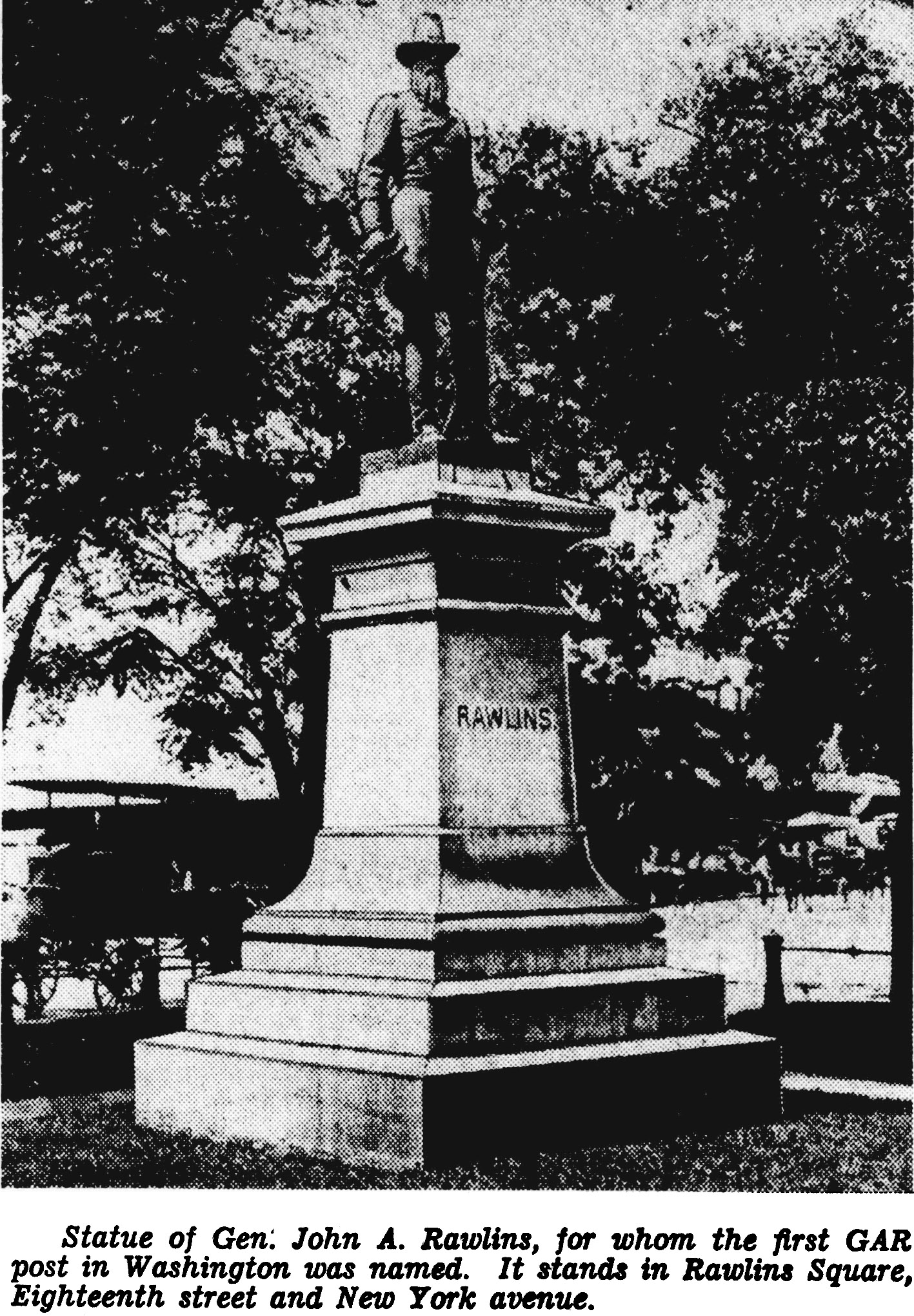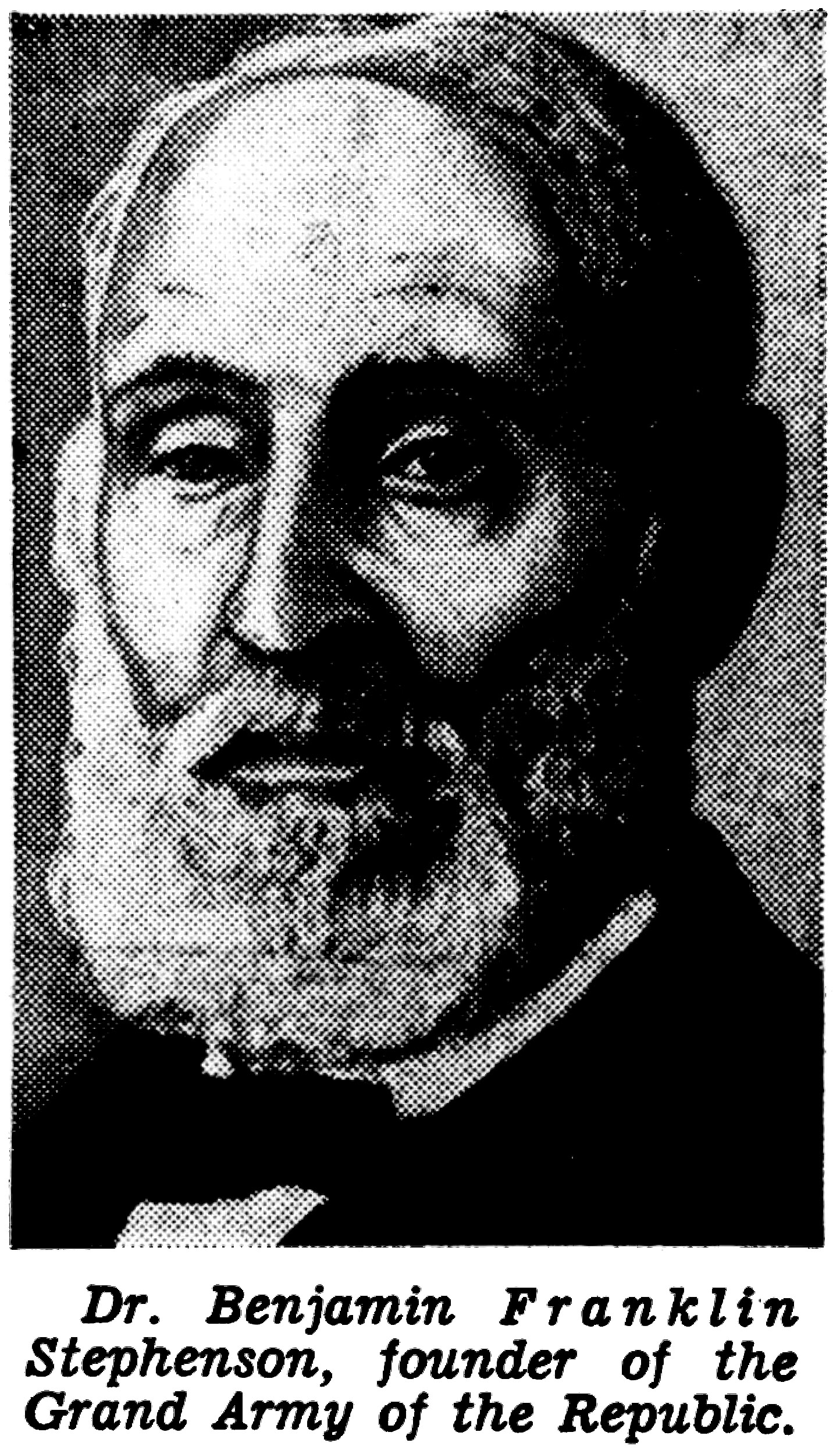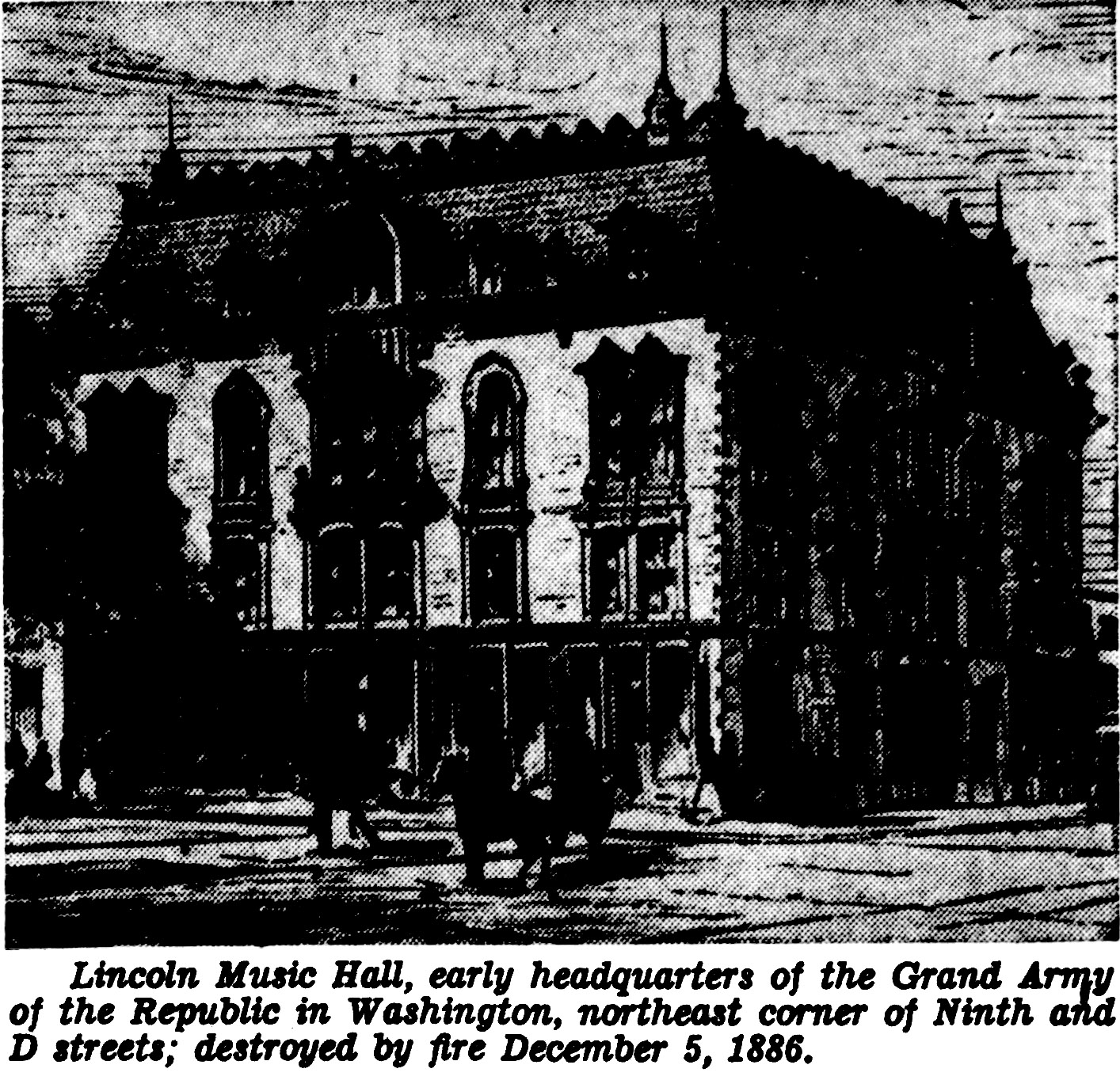Washington's Last Survivor of the G. A. R.
by John Claggett Proctor
The recent death of William F. Dorsey leaves but one survivor of the once vast Department of the Potomac, Grand Army of the Republic, founded by Benjamin Franklin Stephenson, in Decatur, Ill., April 6, 1866. Six months later, on October 12, John A. Rawlins Post, No. 1, was granted the first charter in the District of Columbia, the Department of the Potomac itself being organized on February 13. 1869. The first department commander was Samuel A. Duncan and the last one, John Montgomery Kline, who has outlived all of his fellow comrades of this department.
In 1941, when the local branch of this famous body of men had dwindled to two men, their membership was taken over by the national headquarters at Springfield, Ill., and Mr. Kline and the late Mr. Dorsey were given the rank of past department commanders, and now only the former remains of this once great department of Civil War veterans.
It is interesting to note that this organization originated with an Army surgeon who thought it out while persuing his beneficent labors among the wounded, sick and suffering, as a means to further a lasting bond between those who fought for the Union.,
Origin of the GAR
According to B. F. Beath, in his history of this order, published in 1889. Dr. B. F. Stephenson and the Rev. W. J. Rutledge, chaplain of the 14th Illinois Infantry, were close friends and companions during the war, and that “while on Sherman's expedition to Meridian in February, 1864, Chaplain Rutledge suggested to Dr. Stephenson that the soldiers who had been so closely allied in the fellowship of suffering would, when mustered out of the service, naturally desire some form of association to preserve the friendships and the memories of their common trials and dangers.
“As they talked together, on the march or in bivouac, this thought expanded into the widest fields of conjecture as to the capacity for good in such an organization of veterans and they agreed that if spared they would together work out some such project.
“After the close of their Army service this subject formed the basis of their correspondence until March, 1866, when Chaplain Rutledge met Dr. Stephenson, by appointment, in Springfield, Ill., and spent some time with him in arranging a ritual for the proposed organization.”
City's First Post
As before stated the first Grand Army post formed in this city was John A. Rawlins, No. 1, which, according to the city directory of 1867, had its headquarters at 222 F street north (old numbering). This now would be on the north side of F street between Fourteenth and Fifteenth streets, near Fourteenth.
An item also of interest in this directory is a brief statement as to the object the aims of the organization, which goes on to say: “The Grand Army of the Republic is an organization of the true and tried honorably discharged soldiers to aid with its charity the maimed and helpless soldiers and the dependent families of the fallen, to secure for those returned soldiers who have vainly sought for it themselves, and whose very tattered uniforms seem an evidence of demerit in the eyes of many who never dared to clothe themselves with it and its dangerous responsibilities. Whatever secrecy there is about this organization is only such as surrounds the most benign and powerful civil orders of the day as a necessity for their protection and strength and to better secure their charitable objects.”

for whom the first GAR post in Washington was named.
It stands in Rawlins Square, Eighteenth street and New York avenue.
Department Commanders
The department commanders of this body, and the years they served, follows: L. E. Dudley, provisional commander, 1867-8: Samuel A. Duncan, 1869: Timothy Luby, 1870-1872: Frank H. Sprague. 1873-1875; Benjamin F. Hawkes. 1876; A. H. G. Richardson, 1877; George E. Corson, 1878; Harrison Dingman, 1879; Charles C. Royce, 1880; William Gibson, 1881; Samuel S. Burdette, 1882-3; D. S. Alexander, 1884; Newton M. Brooks, 1885; Jerome B. Burke, 1886-7; Charles P. Lincoln, 1888; William S. O'Dell, 1889; M. Emmett Urell, 1890; James M. Pipes, 1891; A. F. Dinsmore, 1892; Solomon E. Faunce, 1893; Nathan Bickford, 1894; Marion T. Anderson, 1895; John McElroy, 1896, 1920-1; Thomas S. Hopkins, 1897; Arthur Hendricks, 1898; Calvin Farnsworth, 1899; George Slaybaugh, 1900; Israel W. Stone, 1901; Benjamin F. Bingham, 1902; Ivory G. Kimball, 1903; Abram Hart, 1904; A. P. Tasker, 1905; Benjamin P. Entrikin, 1906; Newton Ferree, 1907; John S. Walker, 1908; Edwin Holbrook, 1909; Henry A. Johnson, 1910; George C. Dr. Benjamin Ross, 1911; J, D. Bloodgood, 1912; Thomas H. McKee, 1913; J. K. Gleason, 1914; L. H. Patterson, 1915; Andres J. Huntoon, 1916: Aaron H. Frear, 1917; Samuel G. Mawson, 1918, 1929, 1931; Hiram B. Snyder, 1919; Harrison L. Dean. 1922; John W. Reid. 1923; Briscoe Goodhart, 1924; Hosea B. Moulton. 1925; Charles V. Petteys, 1926: John L. Clem, 1927; William M. Bobb. 1928; Harry T. Dunbar, 1929, and F. J. Young, 1930.

founder of the Grand Army of the Republic.
The subsequent commanders in order have been: William Tindall, William F. Dorsey, John H, Shepherd and John M. Kline, who was the last department commander and served from 1934 to 1941.
At the east side of Seventh street on a line with C street, and just north of Pennsylvania avenue, stands a memorial to Dr. Benjamin F. Stephenson, the projector of the Grand Army of the Republic. The completed monument cost $45,000, of which $10,000 was contributed by the Grand Army, and the rest appropriated by Congress. The designing was done by J. Massey Rhind, and the unveiling occurred on July 3, 1909.
First Headquarters
The first headquarters of the Department of the Potomac was in the old Lincoln Music Hall, at the northeast corner of Ninth and D streets, and. according to the city directory, the offices of this governing body of the GAR were on the third floor.
This building, which covered the entire site of the present structure, known for years as the Academy of Music, was built by the local branch of the Young Men's Christian Association, mainly through the efforts of the Rev. Dr. George Hall, general secretary of that organization, A. S. Pratt being among the local citizens who contributed liberally to the project. The building was erected by Joseph S. Collins, Washington contractor, and from the first it was known as Lincoln Music Hall.
The Young Men's Christian Association was then a young organization in Washington, having had its initial meeting in 1852, in the old Medical Building, which stood for many years, and until about 15 years ago, at the northeast corner of Tenth and E streets northwest, where is now the large building of the Potomac Electric Power Co.
It was then that some 60 men met in this hall for the purpose of organizing the association, including as its first officers and directors some of Washington's best citizens, of whom it may be truly said, “They builded better than they knew.”
Included in the list were A. H. Lawrence, president; W. J. Rhees, recording secretary; W. C. Langdon, corresponding secretary; M. H. Miller, treasurer. The Board of Directors included J. W. Clarke, G. W. Dutton, Thomas Brooks, R. Smallwood, T. M. Hanson, C. W. Schreiner, Thomas Duncan, C. Dusenburg, Charles Pierson, A. B. Johnson, George H. B. White, Dr. J. S. Mackie, J. T. Cochrane, J. C. Whitwell and O. C. Wright. Mr. Rhees, the recording secretary, who was for many years chief clerk of the Smithsonian Institution, was an unusually lovable character, and a man who devoted much of his time to civic work.
Building's History
The Young Men's Christian Association took up its headquarters in the building, where it maintained its parlors and lecture rooms, and where were heard lectures by such celebrated speakers as Henry Ward Beecher, T. De Witt Talmage and Frederick Douglass.
Later, the great diva, Christine Nilsson, sang here in concert, and to vary the program, on January 21, 1880, the National Woman's Suffrage Convention was held here, and a few days later a meeting was held in this hall in favor of suffrage for the District. On December 5, 1885, the Fifth Annual Convention of Labor Unions opened here, and it was also in the old building that the project for erecting Garfield Memorial Hospital was crystallized.
Here also, as early as 1881, we find Prof. Henry C. Spencer conducting the Spencerian Business College, and it was in his classrooms on this corner that many of Washington's most successful men acquired their business education.
In 1884, the main hall in the building was rented to Daniel Herzog of Baltimore, who opened in that year what became known as Herzog's Ninth Street Opera House. The attractions here included nearly everything theatrical: Comedy, tragedy, burlesque, drama, melodrama and all kinds of musical shows. It was not long, however, before Herzog was succeeded in the management of the house by Joseph K. Strasburger, with J. M. Davis as treasurer.
It was while Mr. Strasburger was managing the theater that it caught fire, early on the morning of December 5, 1886, and was completely destroyed, leaving only the bare walls of the once superb Lincoln Hall.
GAR in 1930
Following the destruction of their headquarters, the Grand Army moved to the Cornwell Building at 1412 Pennsylvania avenue, and here it remained until June, 1930, when the square was taken over by the Government and the razing of the structures there was begun September 15 of that year. At this time there then were still left of this organization 130 members and the headquarters and one or more of the posts were moved to the Army and Navy Union Hall, Eleventh and L streets N.W.
Mr. Kline, the last surviving member of the Grand Army of this jurisdiction, is a Pennsylvanian by birth and now in his 97th year, having been born in Milroy, Mifflin County, Pa., July 29, 1847. He was only 16 years of age when he enlisted in the Union Army as a private in Company A, 49th Regiment, Pennsylvania -Volunteer Infantry.

last survivor of the Department of the Potomac,
Grand Army of the Republic.
Photograph taken on his 90th birth day anniversary, July 29,1937.
His service was a very active one, and he participated in many battles in which his regiment was engaged. However, his field service was terminated on June 1, 1864, when he was taken prisoner. This was at the Battle of Cold Harbor, Va., when he was a member of a reconnoitering party commanded by a lieutenant and composed of about 30 men who volunteered for this hazardous duty, in which the entire party was either killed or captured and made prisoners.
Prisoner of War
Mr. Kline was first taken to Libby Prison, Richmond, Va., and subsequently to Andersonville, Ga., and to other Southern prisons, and remained in the hands of the enemy until the close of the war, when, after convalescing from the hardships of imprisonment, and being discharged, he joined the Regular Army on September 29, 1866, and was assigned as corporal to Company K, 12th Regiment, United States Infantry, and served with the regiment in the Department of Washington and Department of the South during the reconstruction period.

northeast corner of Ninth and D streets;
destroyed by fire December 5, 1886.
The 12th Regiment being ordered to Washington, D. C., for the inauguration of President Grant, he marched in the inaugural parade and shortly afterward was ordered to the Department of the Pacific, traveling in the first train to cross the continent over the Union Pacific Railroad, which was unfinished at a point near Ogden, Utah, the regiment marching to Promontory, Utah, where the golden spike was driven by Leland Stanford, Governor of California, marking the completion of the railroad, and the regiment proceeded on its way to San Francisco, establishing headquarters on Angel Island, San Francisco Harbor, and the companies were assigned to different military posts.
Company K, of which Mr. Kline was then a sergeant, was assigned to Camp Gaston, Hoopa Valley, Calif., where he served until September 29, 1869, when he was honorably discharged by reason of the expiration of his term of enlistment.
He then returned to his home in Pennsylvania and after a brief visit there came to Washington, where he secured an appointment in the United States Treasury Department December 1, 1869, receiving merited promotions to chief of division, retiring in 1921 after 52 years' consecutive service.
The Kline Family
Mr. Kline was married here in 1871 to Catherine Alice Parkinson of this city, who died October 21,1917. Four children were bom to them; the first, a daughter, died in Infancy. Three sons are living, Edwin M. Kline, immigrant inspector, Department of Labor; John M. Kline, jr., actor, and James N. Kline, assistant cashier, United States Treasury Department.
Of these. Edwin M. Kline has no issue. John M. Kline, jr., is a veteran of the Spanish-American War and has one son who was not accepted for service, and a daughter Margaret, whose husband, Donald Massey, is now with the forces somewhere in the South Pacific.

near Seventh and C streets N.W.
James N. Kline has three sons and a daughter, namely, James N., jr., who is still to be called to the colors; Charles Edwin, sergeant, recently discharged for disabilities incurred in the service, and Thomas H., corporal, now serving in Italy. The daughter Adele married George O. Medler and has a son.
John M. Kline, the venerable patriarch of the Grand Army, is a Presbyterian, and a life member of the Masonic fraternity, and past supreme representative of the fraternal order of Knights of Pythias, and although he resided in Washington since 1871, yet until a year or two ago he regularly voted in Williamsport, Pa., where he is a member of the Chamber of Commerce.
Only recently he entered the Soldiers' Home Hospital for a rest, and here he is doing fairly well. His faculties are generally good, though his reading has slowed up on account of his failing eye sight. His interest in civic affairs has never ceased, and he still thinks Washington is the finest city in this world.
